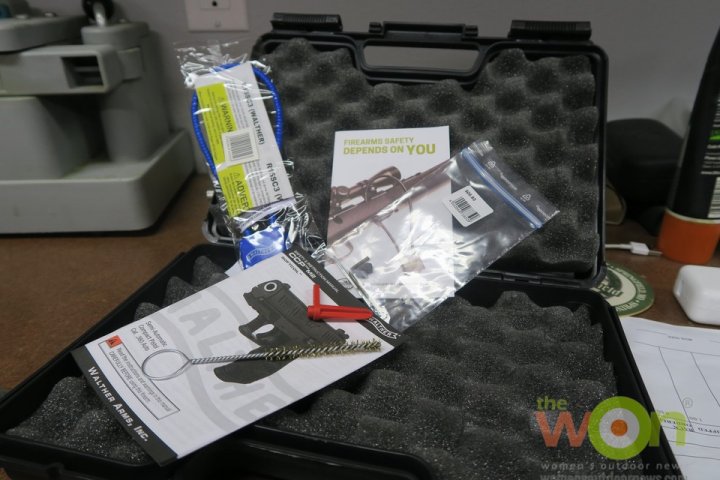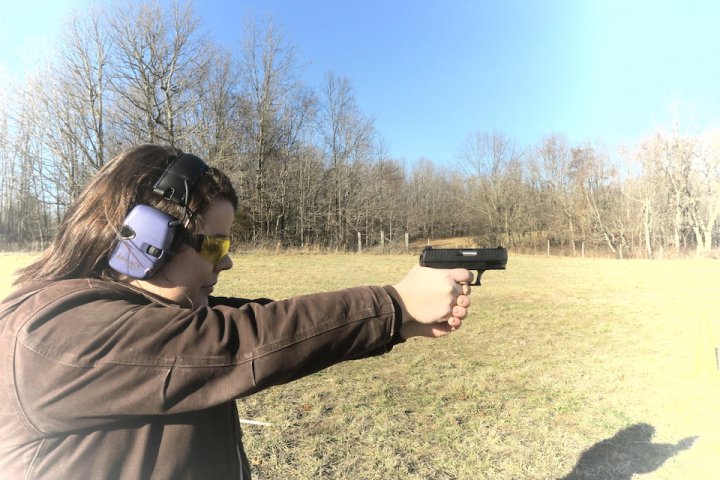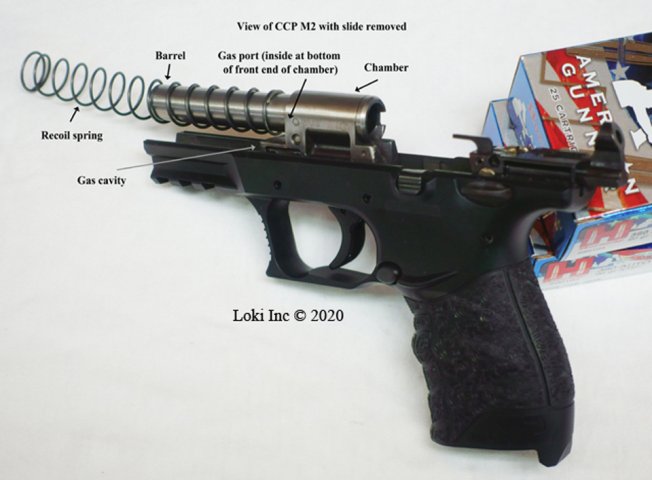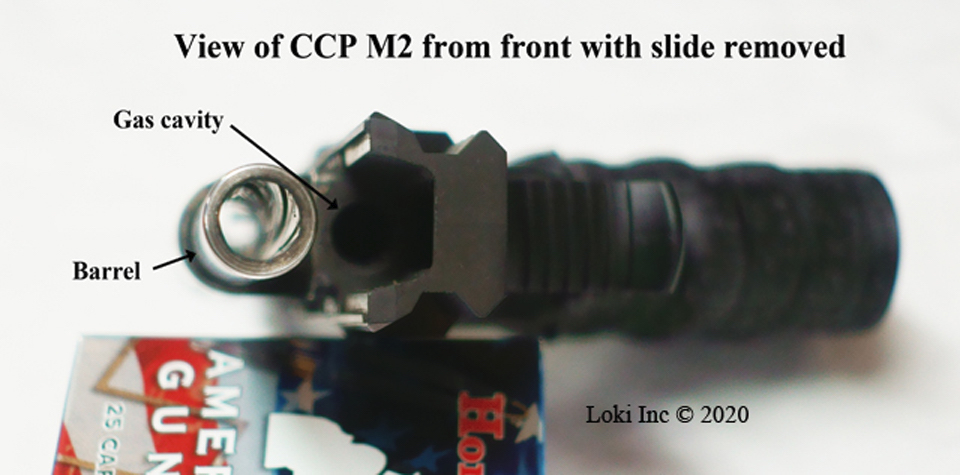Move over EZ Shield. There’s a new little gun in town for the concealed carry market. It’s the Walther CCP M2 in .380 ACP and it slides back and fires again with ease and accuracy.
Sponsored by Walther Arms
Walther introduced its first CCP (concealed carry pistol) in 2016, chambered in 9mm. Women loved it on the range, and hated it at the cleaning bench. So, Walther did a bit of a redesign and introduced the CCP M2 in 9mm, with an easier process of disassembly. It features a tool-free take down mechanism at the rear of the slide.
Here’s a video that shows you how easy it is to disassemble and assemble:
So, after I took the new .380 ACP CCP M2 to my bench and cleaned it, I took it to the range. On that first day, I planned on shooting 100 rounds through it to start breaking it in and had so much fun that I shot 150 rounds before calling it quits. I always start breaking in a new concealed- carry (CCW) gun with controlled target shooting at 7 yards, since that’s the suggested max distance for CCW training purposes. The CCP M2 surprised me with its good accuracy. Later during my break-in run with the gun, I set some steel 8-inch discs out at 25 yards for grins, and surprise! I saw no problems with hitting out there, either.

Then, a few days later, I took it to a women’s shooting clinic at a local range, and the ladies put more rounds through it. The women at the range liked it, and they shot it from 3 to 15 yards on paper and then on steel at 15 yards. By this time, it had digested at least 300 rounds with no malfunctions, with at least 4 types of ammo run through it – including target and personal defense rounds. Some of these women had been used to shooting revolvers, and they remarked at the ease at which they could manipulate the slide and at the gun’s low recoil and therefore, quick target acquisition time. They liked it. I think I sold one already.

Here’s the interesting thing: women who had been told they could only shoot revolvers (by whom, I don’t know – not me), seemed extremely interested in switching over. Their little snub-nosed revolvers, frankly, are not as easy to shoot as a well-made semi-auto. I know there are people who still claim that revolvers are the only way to go for dependability and concealed carry. I understand that, and know that I also carry a revolver (.38 special) in hot weather when I want on-body carry. Also, frankly I believe people who shoot guns should be acquainted with both revolvers and semi-autos. I believe people should know how to drive a manual transmission, as well as an automatic, too. Call me old-fashioned, but you never know when you might have to drive one.
With respect to firearms, a woman needs to know her options and what works for her. Based on the reactions of the women at the range to this gun, I’d say this CCP M2 worked for her … and her and her and her.
Why was the CCP M2 so popular? In addition to the gun’s ergonomics, I think the popularity is due mainly to what Walther calls Softcoil gas technology.
Softcoil gas technology – I know it sounds like a gastronomical problem, but it is a good thing in a gun. It means “gas delayed blowback operation” which frankly sounds like another intestinal problem. Now either skip the next three paragraphs if you are not interested in Softcoil, or bear with me, because I’m going to explain what in the wide world of firearms that means. Most semi-autos on the market have actions that use either recoil or blowback operation. In the explanation below, I’m going to use the word “barrel” to mean the chamber/barrel combination which is all one piece of metal, anyway.

In recoil operation, the recoil spring holds the barrel in place in the frame, and the barrel is mechanically locked to the slide. The recoil spring also returns the slide and barrel back to the firing position after recoil. That’s all it has to do. When the gun fires, for a brief time afterwards high pressure forces the cartridge case to expand against the chamber wall, locking it to the chamber. Since the pistol’s barrel is locked to the slide, the whole combo moves backward (recoils) together, compressing the recoil spring, for a short time until the barrel is mechanically separated from the slide during further rearward movement. The slide pulls the cartridge case from the chamber as it continues to the rear while the barrel drops down into the receiver. The compressed recoil spring then returns everything back to its original position.
In a blowback action, the recoil spring forces the slide forward into strong contact with the barrel, which is fixed to the frame and does not move; the barrel is not mechanically locked to the slide. During firing, the recoil spring must be strong enough to hold the breech face (part of the slide) firmly against the chamber opening (breech) long enough for the cartridge case to remain where it is until high gas pressure pins the case against the chamber wall.
That’s why simple blowback pistols are so hard to rack – you are fighting a very strong recoil spring, much stronger than one in the same caliber recoil-operated action. When the cartridge fires, everything remains in place for a moment, but the rearward pressure on the inside of the cartridge case forces the case back against the breech face and pushes the slide backwards against the recoil spring, compressing it as the slide begins to move.

Here’s where the CCP’s gas delay comes into action. As with other blowback pistols, the CCP M2 barrel is fixed to the frame and does not move. Different from simple blowback designs, however, a gas port in the barrel just ahead of the chamber siphons off high-pressure gas after the bullet travels past it. The gas goes into a cavity below the chamber that encloses the back end of a piston connected to the slide, causing the piston to push forward against the slide, thereby helping hold the breech face against the breech. Therefore, since the recoil spring has help keeping the chamber closed, it doesn’t have to be as stout as with a simple system. Once the bullet escapes the barrel, the gas pressure drops, and the slide recoils away from the barrel. As the slide moves rearward, it extracts the spent cartridge case from the barrel and compresses the recoil spring. The compressed recoil spring then returns the slide back to its original position.

Voila – because of the “gas assist,” the recoil spring doesn’t have to be as stiff as with a straight blowback action, making the slide easier to rack. It also reduces the felt recoil since more recoil energy is consumed operating the action than with either a straight blowback or recoil action of a similar size and caliber. Reduced felt recoil makes it faster to get back on target, since the gun will not move as much during each shot.
For accuracy testing, I set up the gun at 7 yards on a rest for testing with 5 groups of 5 rounds per type of ammo – measuring from the centers of the farthest shots per group and then, taking the average in inches.
Federal American Eagle FMJ, 95 grain: largest group – 1.25; smallest group .75; average – 1.1.
Aguila FMJ, 95 grain: largest group – 1.5; smallest group 1.0; average – 1.3.
Hornady American Gunner HP, 90 grain: largest group – 1.5; smallest group.75; average – 1.2.
Cost is $469 for either the black or stainless model.
Are you wondering what in the wide world of firearms ownership to do when you get that gun? Check out this post, written by me, that will walk you through the process of getting to know what’s going on with that new firearm.
Publisher/Editor Barbara Baird is a freelance writer in hunting, shooting and outdoor markets. Her bylines are found at several top hunting and shooting publications. She also is a travel writer, and you can follow her at https://www.ozarkian.com. View all posts by Barbara Baird